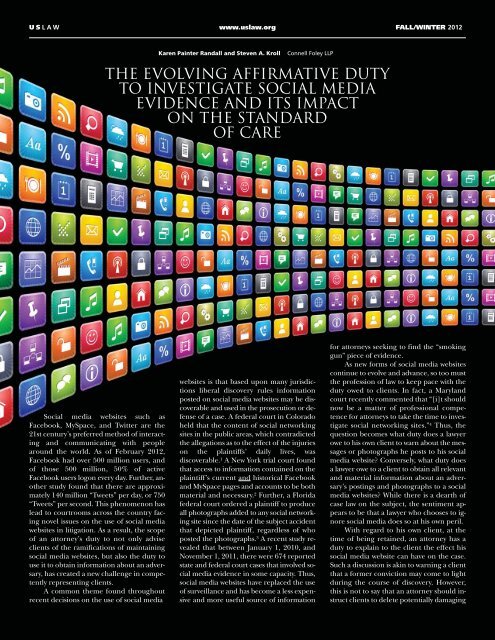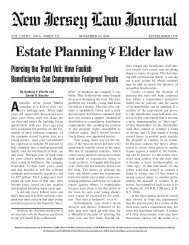The Evolving Affirmative Duty to Investigate Social Media Evidence ...
The Evolving Affirmative Duty to Investigate Social Media Evidence ...
The Evolving Affirmative Duty to Investigate Social Media Evidence ...
Create successful ePaper yourself
Turn your PDF publications into a flip-book with our unique Google optimized e-Paper software.
USLAW www.uslaw.org FALL/WINTER 2012Karen Painter Randall and Steven A. KrollConnell Foley LLP<strong>The</strong> <strong>Evolving</strong> <strong>Affirmative</strong> <strong>Duty</strong><strong>to</strong> <strong>Investigate</strong> <strong>Social</strong> <strong>Media</strong><strong>Evidence</strong> and Its Impac<strong>to</strong>n the Standardof Care<strong>Social</strong> media websites such asFacebook, MySpace, and Twitter are the21st century’s preferred method of interactingand communicating with peoplearound the world. As of February 2012,Facebook had over 500 million users, andof those 500 million, 50% of activeFacebook users logon every day. Further, anotherstudy found that there are approximately140 million “Tweets” per day, or 750“Tweets” per second. This phenomenon haslead <strong>to</strong> courtrooms across the country facingnovel issues on the use of social mediawebsites in litigation. As a result, the scopeof an at<strong>to</strong>rney’s duty <strong>to</strong> not only adviseclients of the ramifications of maintainingsocial media websites, but also the duty <strong>to</strong>use it <strong>to</strong> obtain information about an adversary,has created a new challenge in competentlyrepresenting clients.A common theme found throughoutrecent decisions on the use of social mediawebsites is that based upon many jurisdictionsliberal discovery rules informationposted on social media websites may be discoverableand used in the prosecution or defenseof a case. A federal court in Coloradoheld that the content of social networkingsites in the public areas, which contradictedthe allegations as <strong>to</strong> the effect of the injurieson the plaintiffs’ daily lives, wasdiscoverable. 1 A New York trial court foundthat access <strong>to</strong> information contained on theplaintiff’s current and his<strong>to</strong>rical Facebookand MySpace pages and accounts <strong>to</strong> be bothmaterial and necessary. 2 Further, a Floridafederal court ordered a plaintiff <strong>to</strong> produceall pho<strong>to</strong>graphs added <strong>to</strong> any social networkingsite since the date of the subject accidentthat depicted plaintiff, regardless of whoposted the pho<strong>to</strong>graphs. 3 A recent study revealedthat between January 1, 2010, andNovember 1, 2011, there were 674 reportedstate and federal court cases that involved socialmedia evidence in some capacity. Thus,social media websites have replaced the useof surveillance and has become a less expensiveand more useful source of informationfor at<strong>to</strong>rneys seeking <strong>to</strong> find the “smokinggun” piece of evidence.As new forms of social media websitescontinue <strong>to</strong> evolve and advance, so <strong>to</strong>o mustthe profession of law <strong>to</strong> keep pace with theduty owed <strong>to</strong> clients. In fact, a Marylandcourt recently commented that “[i]t shouldnow be a matter of professional competencefor at<strong>to</strong>rneys <strong>to</strong> take the time <strong>to</strong> investigatesocial networking sites.” 4 Thus, thequestion becomes what duty does a lawyerowe <strong>to</strong> his own client <strong>to</strong> warn about the messagesor pho<strong>to</strong>graphs he posts <strong>to</strong> his socialmedia website? Conversely, what duty doesa lawyer owe <strong>to</strong> a client <strong>to</strong> obtain all relevantand material information about an adversary’spostings and pho<strong>to</strong>graphs <strong>to</strong> a socialmedia websites? While there is a dearth ofcase law on the subject, the sentiment appears<strong>to</strong> be that a lawyer who chooses <strong>to</strong> ignoresocial media does so at his own peril.With regard <strong>to</strong> his own client, at thetime of being retained, an at<strong>to</strong>rney has aduty <strong>to</strong> explain <strong>to</strong> the client the effect hissocial media website can have on the case.Such a discussion is akin <strong>to</strong> warning a clientthat a former conviction may come <strong>to</strong> lightduring the course of discovery. However,this is not <strong>to</strong> say that an at<strong>to</strong>rney should instructclients <strong>to</strong> delete potentially damaging
USLAW www.uslaw.org FALL/WINTER 2012content from their social media websites.This notion was clearly exemplified in Lesterv. Allied Concrete Company, 2011 Va. Cir.LEXIS 132 (Va Cir. Ct. 2011) where a plaintiff’sat<strong>to</strong>rney instructed his client <strong>to</strong> removedamaging evidence from his Facebookpage, which showed the plaintiff as anythingbut grieving, resulting in a severe courtsanction of over $700,000. In addition, inQualcomm, Inc. v. Broadcom Corp., 2008 U.S.Dist. LEXIS 91 (S.D. Cal. Jan. 7, 2008), aCourt ordered Qualcomm <strong>to</strong> pay$8,568,633 for failure <strong>to</strong> produce tens ofthousands of documents requested in discovery.<strong>The</strong> Court also sanctioned six at<strong>to</strong>rneysfrom an outside law firm for blindlyaccepting Qualcomm’s claim that their e-discovery searches were adequate, as well asintentionally hiding or recklessly ignoringrelevant documents. Nevertheless, an at<strong>to</strong>rneyhas a duty <strong>to</strong> warn a client that as the litigationproceeds, even non-public postings,or postings <strong>to</strong> their social media website bya third party may be discoverable.<strong>The</strong> other main duty of an at<strong>to</strong>rneyarises out of the investigation of an adverseparty through social media websites. For example,a defense at<strong>to</strong>rney would not be actingcompetently and diligently in a personalinjury case, if the at<strong>to</strong>rney ignored picturesof a recent trip <strong>to</strong> Hawaii posted by a blissfullylooking plaintiff who is claiming loss ofenjoyment of life. However, an at<strong>to</strong>rneydoes not have carte blanche <strong>to</strong> send “friendrequests” <strong>to</strong> every opposing party he has anactive file with. First, most jurisdictions havea rule prohibiting a lawyer from contactinga represented party without the party’scounsel’s consent. Second, Courts will notpermit a “fishing expedition” in<strong>to</strong> a person’sprivate social media website without areasonable basis. <strong>The</strong>re still must be a “factualpredicate with respect <strong>to</strong> the relevancyof the evidence”, as described by one NewYork appellate court in McCann v.Harleysville Insurance Co. of New York, 78A.D.3d 1524, 910 N.Y.S.2d 614 (N.Y. App.Div. 4th Dept. 2010). Third, most on-line socialmedia is controlled by a non-party serviceprovider. <strong>The</strong> S<strong>to</strong>red CommunicationAct, 18 U.S.C. § 2701 et seq., prohibits electroniccommunication services from revealinga user’s private messages even if theyreceive a subpoena. Further, the extent ofthe privacy protection afforded by theS<strong>to</strong>red Communication Act may dependupon the user’s conduct, i.e., their privacysettings. <strong>The</strong>refore, an at<strong>to</strong>rney is required<strong>to</strong> obtain written authorization from an adverseparty for a non-party <strong>to</strong> reclaim datafrom a private social media website. Despitethese hurdles, an at<strong>to</strong>rney has a duty <strong>to</strong>check all public social media websites forany relevant information. Moreover, at<strong>to</strong>rneysshould begin <strong>to</strong> craft and formulatenew interroga<strong>to</strong>ries, requests for documents,and deposition questions that canhelp form a basis for gaining access <strong>to</strong> potentiallymaterial information and pho<strong>to</strong>graphscontained in an adversary’s privatesocial media website. Similar <strong>to</strong> obtainingwritten authorizations for receipt of a plaintiff’spertinent medical records, at<strong>to</strong>rneysshould also consider requesting written authorizationsfor a plaintiff’s non-public socialmedia websites when deemedappropriate.Another area of the law where socialmedia has played a large role is in an at<strong>to</strong>rney’sdue diligence in serving legal papersupon an adverse party. Courts have recognizeda duty of at<strong>to</strong>rneys <strong>to</strong> perform basicinternet searches <strong>to</strong> find the whereabouts ofa party. One Indiana appellate court wasamazed that the plaintiff’s at<strong>to</strong>rney hadfailed <strong>to</strong> Google an absent defendant as amatter of due diligence, noting that theCourt itself had done so and immediatelyobtained search results that included a differentaddress for defendant as well as anobituary for the defendant’s mother listingnumerous relatives who might have knownhis whereabouts. 5 A Florida appellate courtquestioned the effectiveness of an at<strong>to</strong>rneywho had only checked direc<strong>to</strong>ry assistancein order <strong>to</strong> get an address <strong>to</strong> serve a defendant,calling such a method in the age ofthe Internet the equivalent of “the horseand buggy and the eight track stereo.” 6Moreover, in Louisiana the appellate courtupheld a trial judge’s rejection of a party’sdue diligence claims where that judge hadconducted his own Internet search and concludedthat the proper contact informationfor the defendant was “reasonably ascertainable.”7 <strong>The</strong>refore, an at<strong>to</strong>rney’s duty <strong>to</strong> diligentlyobtain the location of a party forservice purposes has been heightened bythe availability of social media.In a profession based upon traditionand legal precedent, it is apparent that at<strong>to</strong>rneyscannot ignore the technologicalchanges going on around them. Rule 1.1 ofthe ABA Model Rules requires lawyers <strong>to</strong> becompetent in the representation of theirclients. Further, Comment 6 the aforementionedRule advises that lawyers “shouldkeep abreast of changes in the law and itspractice.” Thus, early on in their representationat<strong>to</strong>rneys should discuss the ramificationsof a client’s social media on the matter.In addition, an at<strong>to</strong>rney should perform asearch, using a search engine such asGoogle, for any relevant, public informationavailable not only for his client, but any partiesor witnesses <strong>to</strong> the action. Lastly, anat<strong>to</strong>rney should create a discovery plan thatincludes interroga<strong>to</strong>ries and document requeststhat take in<strong>to</strong> consideration potentiallyrelevant information contained in asocial media website. While a body of caselaw continues <strong>to</strong> develop as <strong>to</strong> the duty withregard <strong>to</strong> social media, the biggest takeawayfor at<strong>to</strong>rneys is that they must be cognizan<strong>to</strong>f these websites and their potential use forbetter or worse in litigation.1Ledbetter v. Wal-Mart S<strong>to</strong>res, Inc., 2009 U.S. Dist.LEXIS 126859 (D. Colo. 2009)2Romano v. Steelcase, Inc., 30 Misc. 3d. 426, 907N.Y.S.2d 650 (N.Y. Sup. Ct. 2010)3Davenport v. State Farm Mutual Au<strong>to</strong>mobileInsurance Company, 2012 U.S. Dist. LEXIS 20944(M.D. Fla. 2012)4Griffin v. Maryland, 995 A.2d 791 (Md. Ct. Spec.App. 2010)5Munster v. Groce, 829 N.E.2d 52 (Ind. Ct. App.2005)6Dubois v. Butler, 901 So. 2d 1029, (Fla. Dist. Ct.App. 2005)7Weatherly v. Optimum Asset Management, 928 So.2d 118 (La. Ct. App. 2005)Karen Painter Randall is aPartner at Connell FoleyLLP. A Certified Civil TrialAt<strong>to</strong>rney, Randall providesrepresentation and advocacyservices <strong>to</strong> a wide rangeof professionals and businessesin complex litigation.Randall is the former Chair of the USLAWProfessional Liability Practice Group and amember of its Leadership Committee. Randallalso manages the Professional Liability andDirec<strong>to</strong>r and Officer Litigation Practice Groupsat Connell Foley, USLAW NETWORK’s NewJersey firm. Randall has lectured and writtenextensively on defense, coverage and risk managementissues while also serving in key leadershippositions with the American BarAssociation, Defense Research Institute andCouncil on Litigation Management.Steven A. Kroll is an associateat Connell Foley LLP inthe Professional Liabilitypractice group. In addition<strong>to</strong> representing professionalsin various areas, Kroll representscommercial landlordsand tenants in mattersrelated <strong>to</strong> premises liability. Kroll is a 2009graduate of Rutgers-Newark School of Law,where he graduated cum laude, and receivedthe distinguished award of Order of the Coif. Formore information on Connell Foley, please visitwww.connellfoley.com or call 973.535.0500.




